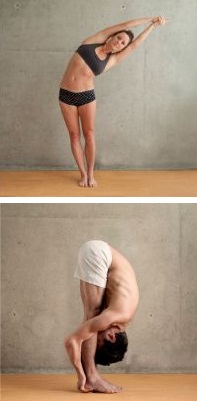Half-Moon with Hands-to-Feet Pose – Step by Step
These are the first two of all Bikram Yoga poses you’ll be performing, and they takes place right after the Standing Deep Breathing Pose and right before the Awkward Pose. Please note that these are actually two poses, but as they are done in very close sequence and each transitions into the other, they are usually referred to as one posture only.
The original name of these poses is Ardha Chandrasana with Pada Hastasana, which translate to “Half Moon Posture” and “Foot-Hand Posture,” respectively.
Benefits and Purposes
The Half-Moon and Hands-to-Feet poses are an excellent way to stretch and vitalize your entire body in preparation for the upcoming poses. Due to nature of the movements, many people benefit from improved body posture as well as reduction in lower back pain when they perform these poses.
A whole spectrum of muscles is worked while performing these two poses, including the abdominal muscles, back muscles, hip flexors, shoulders, thighs and calves. Additionally, a whole spectrum of organs/systems is also exercised: the circulatory (your heart), pancreatic, respiratory, glandular and even the skeletal system. All of the above make the Ardha Chandrasana and Pada Hastasana excellent full-body exercises that can be performed safely by people of all ages and all levels of fitness.
The Half-Moon and Hands-to-Feet poses will also provide bowel stimulation, and will provide a massage session to the nerves surrounding your spine, improving your overall well-being and feeling of comfort in your own body. Additionally, and as a direct cause of all the benefits mentioned, these two poses will help your reduce fat around your buttocks and waistline, and will reduce your anxiety levels due to improved blood circulation and respiration.
Performing The Half-Moon and Hands-to-Feet Pose

- First, completely lock your arms and make sure your arm muscles are flexed.
- Lift your hands upwards (above your head) and make sure your entire body is extended in the direction of the ceiling.
- After holding this position for a while, bend backwards while taking care that the bend should happen across the length of your entire spine, not just at the hips, as the latter could result in an injury.
- Start bending at the hips to to the right and left, as seen in the first picture above. Do it slowly.
- After performing the half-moon for a minute or two, transition towards the Hands to feet posture (second picture above). The goal here is to bring your torso as close to your legs as possible while keeping your knees locked-in (as straight as possible).
- At this stage, make sure your elbows are positioned behind your calves, and that they are brought as close together as possible. This will seem like impossible to achieve for a beginner, but it will get much easier with time.
- Once your torso is glued to your legs, start to slowly move your head down your shins as far as you can, without allowing your body to sway forward.
Extra Tips
Despite it being the first of all 26 beginner poses, the Half-moon with Hands-to-feet posture is one of the most “difficult.” I put difficult inside quotes because there actually isn’t a specific goal you need to achieve when performing it, not in terms of the range of motion at least. The real goal is to stretch and stimulate your muscles, organs, nerves and skeletal system as much as possible. If you are very inflexible, then you will still have achieved these goals even if you only managed to bend back/down half the way through and not an inch more. In other words, don’t try to compare yourself to the highly-experienced Bikram Yoga practitioners in different videos and pictures; you are gaining just as many benefits with whatever range of movement you can reach, as they are with their own range of movement.
Half-Moon with Hands-to-Feet Posture How-To Video
Below is a detailed video with a small group of people demonstrating the Ardha Chandrasana with Pada Hastasana. The video is 4 minutes long and it showcases both poses, as well as the transition between them.